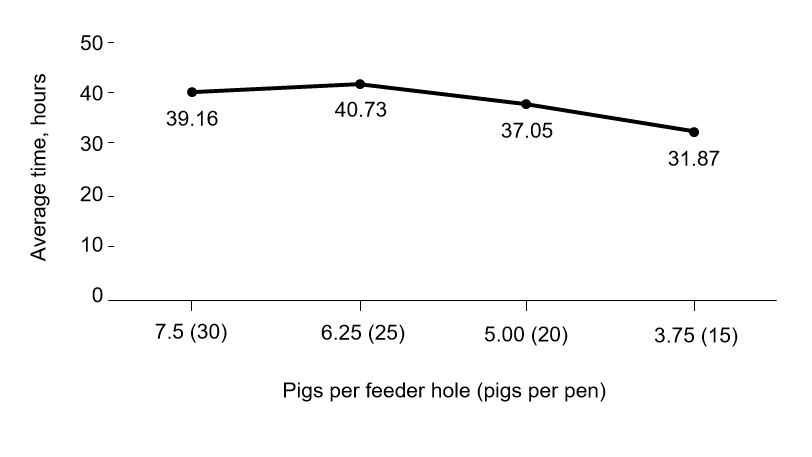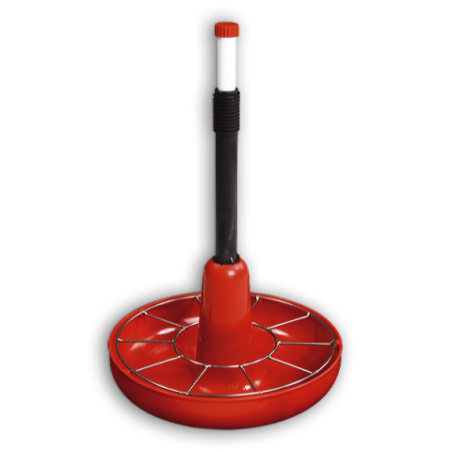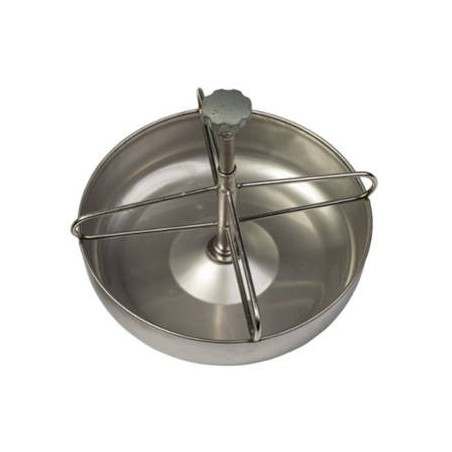Feeders are the final interface between pigs and the diets designed to meet their nutrient needs. Feeder space allowance should be sufficient to ensure all individuals in the group have access to feed, regardless of their competitive ability. The number of pigs per feeder hole may be defined as the amount of pigs per available space (feeder hole) in the pen (i.e., 10 pigs per feeder hole). Providing adequate (but not excessive) feeder space is essential for success in pig barn management.
There is much interest and controversy over what the optimum group size is for maximum performance in the post-weaning period, particularly in light of the tendency toward using large group sizes (>100-150) as a strategy to minimize facility costs, maximization facility use, and improve overall profitability. It is important to mention that increased group size is sometimes confounded with a decrease in stocking density, so caution must be taken when interpreting data and information about this topics.

The effect of number of pigs per feeder hole and group size on growth performance
Recent studies have showed that both feeder space and increased group size might affect average daily gain and feed intake during the nursery period (Laskoski et al., 2019). Increasing feed intake to improve pig growth rate immediately after weaning could be one strategy to increase the performance of post-weaning pigs. Laskoski et al. (2019) tested the effects of pigs per feeder hole and group size on feed intake onset and growth performance in nursery pigs with consistent space allowance (0.23 m²/pig), and observed that pens with 3.75 pigs per feeder hole, or 15 pigs per pen, had the shortest average time to the onset of feed intake after weaning (Fig. 1) and highest average daily feed intake in the first 14 days post-weaning compared to the other treatments. In the same study, a linear increase in growth rate when the number of pigs per feeder hole decreased by changing the group size was observed. Although no significant effects were reported on the percentage of removals during the nursery phase by decreasing the group size from 7.5 to 3.75 pigs per feeder hole, the results of this study indicate a numerical reduction in the removals during the period (4.3% vs 0.9% respectively).

The effect of number of pigs per feeder hole and group size on the occurrence of tail and ear lesions
Increasing group size may lead to increased social tension and aggressiveness in pigs (Randolph et al.,1981; Curtis, 1996). However, the casual observations (Wolter & Ellis, 2000) revealed no signs of abnormal behavior, such as tail or ear biting, as a result of increasing group size post-weaning. The competition for feed may be the main factor involved in triggering aggressive interactions between the animals, and reduced availability of feeder space is reported as a risk factor for tail biting. Laskoski et al. (2019) demonstrated that 6.25 pigs per feeder hole can reduce the occurrence of ear lesions, while tail lesions were reduced with 3.75 pigs per feeder hole. This shows that restriction of feeder space may explain the occurrence of the tail and ear lesions (Table 1), even with ad libitum feed intake, and feeder space may be associated with an occurrence of this behavior in nursery pigs.
Table 1. Tail and ear lesions according to the number of pigs per feeder hole over the entire nursery period*
| Pigs per feeder hole (Group size) | ||||
|---|---|---|---|---|
| 7.50 (30) | 6.25 (25) | 5.00 (20) | 3.75 (15) | |
| Tail lesions, % | 11.9b | 9.7b | 6.4b | 0a |
| Ear lesions, % | 5.7b | 0a | 0.7a | 0a |
* A total of 630 pigs (initial BW 5.59 ± 0.9 kg) were used with 0.23 m² of floor space allowance per pig and 7 replicate pens per treatment. The nursery period is classified as weaning to 42 days.
a,b Percentages followed by different letters within the row differ statistically (P <0.05)
In summary, Laskoski et al. (2019) reported that decreasing the number of pigs per feeder hole through a reduction in group size while maintaining a consistent space allowance:
- Reduced the incidence of ear and tail lesions;
- Tended to increase growth rate during the overall period;
- Reduced the time to onset of feed intake and increased feed consumption in the initial phase of the nursery period.
For this reason, reducing the number of pigs per feeder hole by decreasing group size can be a valid strategy to improve growth performance and animal welfare, mainly when space allowance is restricted.







